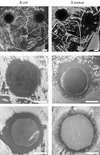Antibacterial nanoparticle monolayers prepared on chemically inert surfaces by cooperative electrostatic adsorption (CELA)
- PMID: 20423140
- PMCID: PMC2884101
- DOI: 10.1021/am100045v
Antibacterial nanoparticle monolayers prepared on chemically inert surfaces by cooperative electrostatic adsorption (CELA)
Abstract
Cooperative electrostatic adsorption (CELA) is used to deposit monolayer coatings of silver nanoparticles on relatively chemically inert polymers, polypropylene, and Tygon. Medically relevant components (tubing, vials, syringes) coated by this method exhibit antibacterial properties over weeks to months with the coatings being stable under constant-flow conditions. Antibacterial properties of the coatings are due to a slow release of Ag(+) from the particles. The rate of this release is quantified by the dithiol-precipitation method coupled with inductively coupled plasma optical emission spectrometer (ICP-OES) analysis.
Figures





References
-
- Son WK, Youk JH, Lee TS, Park WH. Macromol. Rapid Commun. 2004;25:1632–1637.
-
- Feng QL, Wu J, Chen GQ, Cui FZ, Kim TN, Kim JO. J. Biomed. Mater. Res. 2000;52:662–668. - PubMed
-
- Pai MP, Pendland SL. Ann. Pharmacother. 2003;37:192–196. - PubMed
-
- Li Y, Leung P, Yao L, Song QW, Newton E. J. Hosp. Infect. 2006;62:58–63. - PubMed
Publication types
MeSH terms
Substances
Grants and funding
LinkOut - more resources
Full Text Sources
Other Literature Sources

